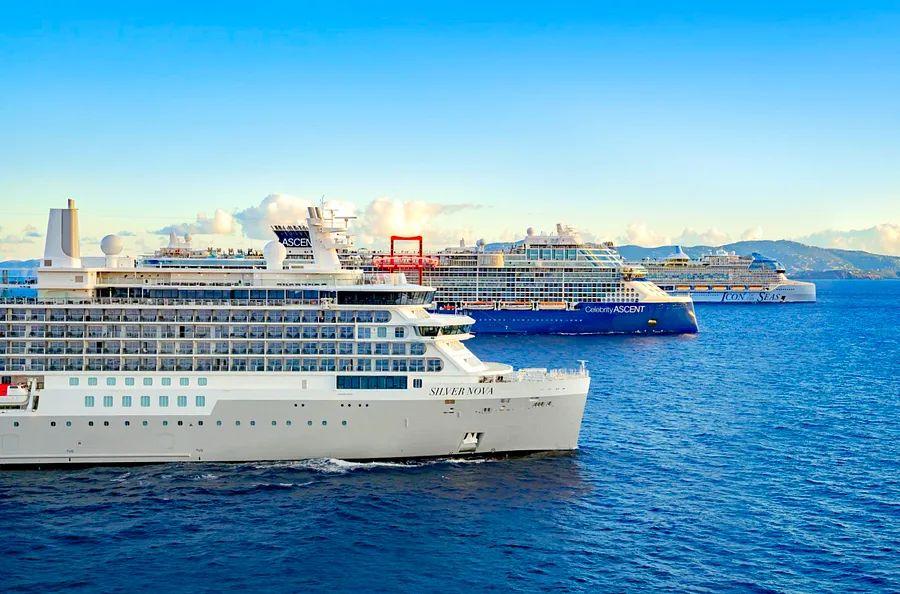Curious about how cruise ships turn a profit? Discover the various ways your favorite cruise brands generate income.

Have you ever wondered, "What are the revenue streams for cruises?" You might be surprised to find out that ticket sales account for only 65% to 70% of cruise lines' earnings, even with this year's prices skyrocketing due to high demand.
If cruise fares aren't the sole source of income, what other avenues contribute to a cruise ship's profitability? This article delves into ticket sales, additional revenue streams, and the factors influencing them, along with the percentage breakdown for each cruise line parent company.
Revenue from ticket sales
 DIMA_SIDELNIKOV/GETTY IMAGES/ISTOCK PHOTO
DIMA_SIDELNIKOV/GETTY IMAGES/ISTOCK PHOTOFor the three leading cruise line parent companies—Carnival Corp., Norwegian Cruise Line Holdings, and Royal Caribbean Group—ticket sales represent roughly two-thirds of their total revenue.
According to a research report published on May 29, Truist Securities forecasted that ticket sales, including cruise fares and flights booked through cruise lines, will contribute 66.1%, 67.5%, and 69.6% to the revenue of these three companies in 2024, respectively.
Spending on board
 ATU IMAGES/GETTY IMAGES
ATU IMAGES/GETTY IMAGESTruist Securities also estimated that onboard spending will make up the remaining 33.9%, 32.5%, and 30.4% of revenue for the Carnival Corp., Norwegian Cruise Line Holdings, and Royal Caribbean Group brands in 2024, respectively.
Onboard spending includes a range of offerings such as shore excursions, drink packages, Wi-Fi, gaming options like casinos and arcades, alternative dining, spa services, and items purchased from onboard shops. Additionally, it covers airport shuttles, travel insurance or protection bought through the cruise line, and even cancellation fees.
"Our focus is on experiences," stated Jason Liberty, president and CEO of Royal Caribbean Group, during a February 1 earnings call. "We continuously strive to enhance experiences that our customers want and are willing to invest in. We're adding numerous features to our ships and expanding our offerings at destinations, particularly in our private island initiatives. Our aim is to keep customers engaged within our ecosystem," he added.
The importance of location
 KENT WEAKLEY/GETTY IMAGES/ISTOCKPHOTO
KENT WEAKLEY/GETTY IMAGES/ISTOCKPHOTOAs expected, the per diem—the total amount each passenger spends daily for sailing, including ticket and onboard expenses—tends to be higher in more remote areas compared to popular tourist destinations.
For instance, per diem costs are notably higher in regions like Alaska and Europe compared to the Caribbean and the Bahamas. This is influenced by supply and demand, as there are significantly more ships offering trips to the latter destinations, which results in lower prices in the Caribbean and the Bahamas.
Moreover, travelers heading to bucket list locations tend to be more inclined to invest in excursions or unique experiences they might not encounter again. The more exotic the destination, the scarcer the excursion opportunities, which often leads to higher prices. For example, while snorkeling or parasailing is available in nearly every Caribbean location, only a handful of places around the globe offer glacier trekking.
On the other hand, passengers booked on three-night weekend cruises may face tighter budgets and, as a result, might be less inclined to splurge on extras.
An emphasis on prebooking
 CARNIVAL CRUISE LINE
CARNIVAL CRUISE LINEIn recent earnings calls, cruise line leaders have emphasized their efforts to encourage passengers to prebook activities and experiences. The idea is that even if cruisers secure shore excursions, spa services, and alternative dining options before boarding, they are still likely to make additional purchases on the ship, resulting in higher overall spending.
"One of the significant advancements we've noticed is the ability for guests to purchase and plan their vacations in advance," stated Naftali Holtz, CFO of Royal Caribbean Group, during the February 1 earnings call. "This also leads to greater financial success, as those who book their activities ahead of time tend to spend two and a half times more once they're onboard than those who don't."
"Regarding the Norwegian brand, we are continuously enhancing our presale initiatives to capture more onboard revenue and increase customer spending over an extended period, starting from when they enter our ecosystem," noted Mark Kempa, EVP and CFO of Norwegian Cruise Line Holdings, during the February 27 earnings call. "This is crucial as we explore future revenue opportunities."
"We have been enhancing our precruise planning tools at Norwegian, enabling guests to make even more bookings before they depart from home," explained Harry Sommer, president and CEO of Norwegian Cruise Line Holdings, during the same call.
The bottom line
How do cruise lines generate revenue? Their income comes from two primary sources: ticket sales (including cruise fares and airfare booked through the cruise lines) and onboard spending (purchases of cruise-related goods and services, along with cancellation fees).
Even though current fares are among the highest in cruise history, lines are concentrating on boosting revenue from onboard spending by encouraging booked passengers to make purchases well before their departure.
Got cruise questions? TPG has the answers:
- More prohibited items: What should you leave out of your cruise packing list?
- What is baked Alaska, and why is it showcased on cruise ships?
- Which are the largest cruise ships in existence?
- What role does a gentleman host play on a cruise?
- What is the Jones Act, and how does it impact cruise operations?
- What exactly is a lido deck on a cruise ship?
- What does a cruise cabin guarantee entail, and can it save you money?
- What distinguishes a cruise concierge from a butler?

1

2

3

4

5
Evaluation :
5/5